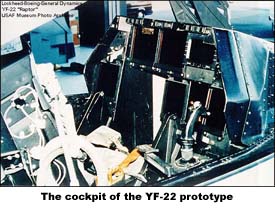
The F-22's cockpit is one of the very first "all-glass" cockpits for tactical fighters - there are no traditional round dial, standby or dedicated gauges. It accommodates the largest range of pilots (the central 99 percent of the Air Force pilot population) of any tactical aircraft. It is the first baseline "night vision goggle" compatible cockpit, and it has designed-in growth capability for helmet-mounted systems. The canopy is the largest piece of polycarbonate formed in the world with the largest Zone 1 (highest quality) optics for compatibility with helmet-mounted systems. While functionality is critical, the F-22's cockpit design also ensures pilot safety with an improved version of the proven ACES II ejection seat and a new pilot personal equipment and life support ensemble.

